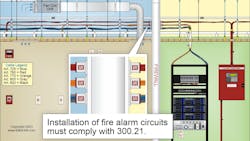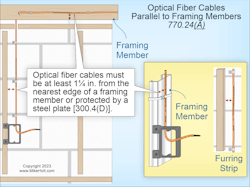Article 760 covers the installation of wiring and equipment for fire alarm systems. Residential smoke alarm systems, including interconnecting wiring, are not covered by Art. 760 because they are not powered by a fire alarm system as defined in NFPA 72, National Fire Alarm and Signaling Code.
A “fire alarm circuit” is the wiring connected to equipment powered and controlled by the fire alarm system [Art. 100]. Fire alarm systems include fire detection and alarm notification, guard’s tour, sprinkler water flow, and sprinkler supervisory systems. Other circuits that might be controlled or powered by the fire alarm system include building safety functions, elevator capture, elevator shutdown, door release, smoke doors and damper control, fire doors and damper control, and fan shutdown.
Other Articles
Fire alarm circuits and equipment must comply with Sec. 760.3(A) through (O). Article 300 does not apply, except where specifically referenced within Sec. 760.3. Here, we’ll look at most of these requirements.
Fire alarm circuits and equipment must comply with Sec. 760.3(A) through (O). Article 300 does not apply, except where specifically referenced within Sec. 760.3. Here, we’ll look at most of these requirements.
(A) Installation of fire alarm circuits must comply with Sec. 300.21 (Fig. 1).
(B) Fire alarm cables installed in ducts or plenum spaces must comply with Sec. 300.22.
Exception No. 1: Power-limited fire alarm (PLFA) cables selected per Table 760.154 and installed per Sec. 760.135(B) and 300.22(B) Exception can be installed in ducts specifically fabricated for environmental air.
Exception No. 2: PLFA cables selected per Table 760.154 and installed per Sec. 760.135(C) can be installed in plenum spaces.
(C) Fire alarm circuits installed in corrosive, damp, or wet locations must be:
- Identified for use in the operating environment [Sec. 110.11].
- Of materials suitable for the environment in which they are to be installed.
- Of a type suitable for the application [Sec. 300.5(B), Sec. 300.6, Sec. 300.9, and Sec. 310.10(F)].
(D) Building control systems with Class 2 circuits (elevator capture, fan shutdown, and so on) associated with the fire alarm system, but not controlled and powered by the fire alarm system, must be installed per Art. 725.
(G) If a raceway or sleeve is subjected to different temperatures, and where condensation is known to be a problem, it must be filled with a material approved by the authority having jurisdiction that will prevent the circulation of warm air to a colder section of the sleeve or raceway per Sec. 300.7(A).
(I) Raceways must be large enough to permit the installation and removal of cables without damaging conductor insulation [Sec. 300.17].
When all conductors within a raceway are the same size and insulation, the number of conductors permitted can be found in Annex C for the raceway type. For conductors not included in Chapter 9 (such as multiconductor cable), the actual dimensions must be used. If one multiconductor cable is used inside a raceway, the single-conductor percentage fill area must be used [Chapter 9, Notes to Tables, Note 5 and 9].
(J) When a raceway is used to support or protect cables, a bushing is required to reduce the potential for abrasion. Place it where the cables exit the raceway per Sec. 300.15(C).
(O) The listing and installation of cables for PLFA circuits must comply with Part III of Art. 760 and Parts I and II of Art. 722.
Workmanship
Don’t let an accumulation of cables prevent the removal of suspended ceiling panels [Sec. 760.21]. Install these cables and other parts of fire alarm circuits in a neat and workmanlike manner [Sec. 760.24(A)].
Exposed fire alarm cables must be supported by the structural components of the building in such a way that the cable(s) will not be damaged by normal building use.
Fire alarm cables must be secured by hardware (e.g., straps, staples, hangers, listed cable ties, or similar fittings) identified for securement and support used in a manner that will not damage the cable.
Fire alarm cables installed through (or parallel to) framing members or furring strips must be protected where they are likely to be penetrated by nails or screws. Do this by installing the wiring method so it is at least 11/4 in. from the nearest edge of the framing member or furring strips, or by protecting it with a 1⁄16-in.-thick steel plate or equivalent [Sec. 300.4(A) and (D)], as shown in Fig. 2.
You can’t support raceways or cables by using ceiling-support wires or the ceiling grid. You can support raceways or cables by using independent support wires secured at both ends or attached to the suspended ceiling per Sec. 300.11(B).
Paint, plaster, cleaners, abrasives, corrosive residues, or other contaminants might result in an undetermined alteration of fire alarm cable properties.
Abandoned cables
An “abandoned cable” is one that’s not terminated at equipment other than a termination fitting or a connector and is not identified for future use with a tag [Art. 100]. Where cables are identified for future use with a tag, the tag must be able to withstand the environment involved.
To limit the spread of fire or products of combustion within a building, abandoned fire alarm cables must be removed [Sec. 760.25].
Identification
Fire alarm circuits must be identified at terminal and junction boxes. The identification must be in a manner that will help to prevent unintentional signals on the fire alarm system circuits during testing and servicing of other systems [Sec. 760.30]. Red raceways and fittings are sometimes used, but that color is not required by the NEC.
A listed surge-protective device must be installed on the supply side of a fire alarm control panel per Part II of Art. 242 [Sec. 760.33].
PLFA circuits
A “Power-Limited Fire Alarm” circuit is one that’s powered by a power-limited source [Art. 100]. The power source for PLFA equipment must be listed. It can be a PLFA transformer, PLFA power supply, or equipment marked to identify the PLFA power source [Sec. 760.121(A)].
PLFA equipment must comply with the following [Sec. 760.121(B)]:
(1) The branch circuit supplies no other loads.
(2) The branch circuit is not GFCI or AFCI protected.
(3) The location of the branch-circuit overcurrent protective device for the PLFA equipment must be identified at the fire alarm control unit.
(4) The branch-circuit disconnect must be accessible only to qualified personnel. It must also be identified in red and as the “FIRE ALARM CIRCUIT.” The red identification must not damage the overcurrent protective device or obscure any manufacturer’s markings (see Fig. 3).
(5) The fire alarm branch-circuit disconnect can be secured in the closed (on) position.
Fire alarm equipment supplying PLFA cable circuits must be durably marked to indicate each circuit that is a PLFA circuit [Sec. 760.124]. Conductors and equipment on the supply side of the PLFA power supply must be installed per Chapters 1 through 4. Transformers or other devices supplied from power-supply conductors must be protected by an overcurrent device rated not over 20A [Sec. 760.127].
Cable splices and terminations of PLFA conductors must be made in listed fittings, boxes, enclosures, fire alarm devices, or utilization equipment [Sec. 110.3(B) and Sec. 300.15].
Where installed exposed, cables shall be adequately supported and installed to maximize protection against physical damage. If within 7 ft of the floor, cables must be securely fastened in an approved manner at intervals of not more than 18 in. [Sec. 760.130(B)(1)].
Cables shall be installed in metal raceways or rigid nonmetallic conduit where passing through a floor or wall to a height of 7 ft above the floor, unless adequate protection can be afforded by building construction such as detailed in Sec. 760.130(B)(1) or unless an equivalent solid guard is provided [Sec. 760.130(B)(2)].
PLFA cables are not permitted to be placed in any enclosure, raceway, or cable with power conductors unless separated by a barrier [Sec. 760.136(A) and (B)]. Separation is required to prevent a fire or shock hazard that can occur from a short between the fire alarm circuit and the higher-voltage circuits.
PLFA conductors can be installed with power conductors where introduced solely to connect to equipment associated with power circuit conductors, and a minimum of 1/4-in. separation is maintained from the PLFA conductors from the power conductors [Sec. 760.136(D)].
PLFA cables are not permitted to be strapped, taped, or attached to the exterior of any raceway as a means of support [Sec. 760.143].
Getting it right
Section 760.3 references a large number of other Articles. Make sure you understand what those articles require and how those requirements specifically apply to fire alarm systems. Other important factors in a Code-compliant fire alarm system are the workmanship, treatment of abandoned cables, identification of fire alarm circuits, and how you handle PLFA circuits.
About the Author

Mike Holt
Mike Holt is the owner of Mike Holt Enterprises (www.MikeHolt.com), one of the largest electrical publishers in the United States. He earned a master's degree in the Business Administration Program (MBA) from the University of Miami. He earned his reputation as a National Electrical Code (NEC) expert by working his way up through the electrical trade. Formally a construction editor for two different trade publications, Mike started his career as an apprentice electrician and eventually became a master electrician, an electrical inspector, a contractor, and an educator. Mike has taught more than 1,000 classes on 30 different electrical-related subjects — ranging from alarm installations to exam preparation and voltage drop calculations. He continues to produce seminars, videos, books, and online training for the trade as well as contribute monthly Code content to EC&M magazine.



